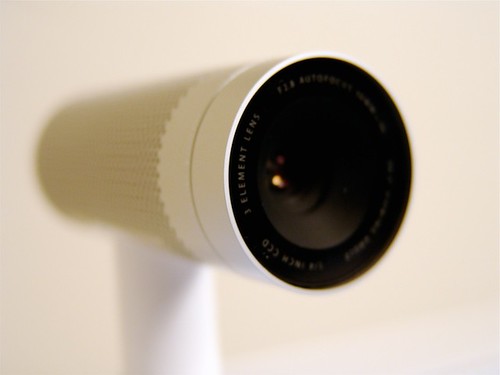Objectified
“Why do we feel like we need to keep visiting the archetype over and over and over again?” asks Karim Rashid, a New York designer. The camera, for example, which since digital photography’s complete obliteration of film has absolutely no reason to remain a metal rectangle.
Flying back from Chicago last night (and admittedly procrastinating a certain final paper), I threw open on of my favorite archetypes (the laptop) and watched the documentary Objectified. I had missed the chance to see it when it was screened at the Corcoran last summer (tickets were scarce, even for Steve) but decided to make up for lost time.
Objectified considers, well, our objects. It covers the gamut from industrial design, to interaction design, and even touches on the contemporary issues of sustainability and cross-cultural design. Slap it up there with its sibling Helvetica, the designer’s chick-flick where you know the cast of characters, and more or less how it will end. It gets thumbs up from me, but I’ll admit I am a sucker for seeing large pieces of scary machinery pop out friendly-looking industrial designs while listening to smart people talking about the things that they love.
And the love abounds. The documentary features an impressive collection of designers. Some of the favorites, including Moggridge, Ive, and Fukasawa, as well as some with whom I am less familiar.
Like Karim Rashid, who’s perspective was so fresh yet familiar, and for all the wrong reasons; I found myself watching his interview again and again. Rashid describes his work as speaking to a “techno-organic” world and as a “physical interpretation of the digital age.” In his interview he speaks about this relationship through our insistence on frequently expired forms.
We have advanced technologically so far, and yet somehow is almost some sort of paranoia where we’re afraid to really say ‘We live in the third technological revolution.’ I have an iPod in my pocket, I have a mobile phone, I have a laptop, but then somehow I end up going home and sitting on wood spindle… chairs. So in a way you could argue that we’re building all these kind of really kitsch stage sets that have absolutely nothing to do with the age in which we live in…
I find it… extremely perverse…
Watching this movie, you can’t help but think about the objects that fill your daily life and the work that went into creating them. However, I am also left wondering about the future of the product, consumerism, and the role of the “designer.”
Paola Antonelli, Design Curator for the MOMA, has one idea that is both optimistic and probable. Teasing the French for turning to philosophers as the arbiters of culture, she lauds designers for their expertise in converting complex ideas into something more comprehensible. The result?
“I… envision [designers] as the culture generators of the future.”



August 26th, 2010 at 4:39 am
oh vom!To two ideas, not yours, but quoted here that I also target in my diss proposal. One, that designers are privileged seers and purveyors of *the* future (Antonelli). Isn’t this an idea that requires us to become desiring followers of a particularly small, elite set of people who don’t know or deal with our daily circumstances? This is a somewhat widely held, not often formally stated, sentiment and I find it interesting to understand how designers became the future when, designers are more commonly the marketing arm of mass production. I love design, but the way we talk about design is highly ideological in how it recuperates consumption.
Two, relatedly, the chairs and wooden spindles are not the past. They are present in our bodies, in our habits, in the things that we can go to for consistency. Rashid sounds like a futurist which wants to disrupt all that is known as bad to generate more design opportunities for himself. We all know how well modernist revolutions went in a lot of places. There’s a place for marking as new and a place for ongoingly refreshing what is more familiar. Our wooden tables are thoroughly modern anyways, made across the world in factories in even larger scale and lower cost.
I love you! 😀 Vive the debate!
August 28th, 2010 at 4:20 pm
I think these are fair an interesting points. When I heard Karim talk (and granted this was a bit ago now), it almost seemed as if he was trying to materialize the kind of wonder – visually and socially – that we all approached the internet with. For me, the interesting questions here are about ideology and materiality. I don’t think the issue is whether Karim is correct or not (although his notion of domestic spaces as perverse is amusing), but rather what are the various factors that reify current ideas and prevent us (perhaps appropriately) from enacting “the age we live in” — whatever that is.
August 28th, 2010 at 4:41 pm
perhaps rashid wants to enchant everything, and he’s entitled to try. I just read a book called The Problem of Presence and one of the things it was pointing to is that not everything is a sign. The fact that certain things are semiotically significant and others are not — some media, in the book’s case, are channels of god and others are not — is itself a cultural phenomenon. Semiotic ideology is the term engelke employed. Seems related to the semiotic ideologies that govern everyday life and the contacts between designers and their consumers/publics, what have you.